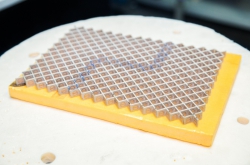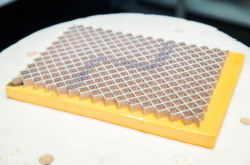September 1, 2017: triple resonance
On September 1, the Fano resonance in Photonics review by scientists from ITMO's Faculty of Physics and Engineering was published in Nature Photonics magazine. For the review's authors, this was truly a signature date: on the same day, the new Faculty of Physics and Engineering accepted its first students, and so did ITMO's new affiliated Department of Dielectric and Semiconductor Photonics in the Ioffe Institute. The new Department is headed by Mikhail Limonov, one of the review's authors, senior researcher at ITMO's Metamaterials laboratory and chief research fellow at the Ioffe Institute.
According to Mr. Limonov, the essential task of the new department is to incorporate all of the advantages that ITMO University and Ioffe Institute can provide: ITMO's rapid development and great infrastructure and Ioffe Institute's profound experimental base in physics as well as its world-renowned scientists. The educational program will be conducted at Ioffe Institute; yet, the students will be able to participate in any scientific events conducted by or with the help of ITMO University - for instance, the annual Metanano international conference organized by ITMO University's Department of Nano-Photonics and Metamaterials.
Among the lecturers of the new Master's program are such renowned scientists as Nikita Averkiev and Evgeniy Terukov from the Ioffe Institute, as well as the recent Presidential Award winners Pavel Belov and Alexandra Kalashnikova from ITMO University.
 Students of the Faculty of Physics and Engineering
Students of the Faculty of Physics and Engineering
In the course of two years of the new Master's program, its students will have the opportunity to create sufficient groundwork to successfully study their future PhD programs, be it in Russia or abroad. The department's lecturers have great experience and connections in what has to do with collaboration and exchange programs with scientific centers in Germany, Great Britain, Holland, USA, Mexico, Israel, Australia, and Finland. The students will also have the opportunity to apply their knowledge to practical tasks that have to do with developing new types of solar cells, nano heterostructures, and many other fields of photonics industry.
How resonances change our lives, make objects invisible and provide for creating ultra-sensitive sensors
What do clock tickers, guitar strings, radio receivers and lasers have in common? All of them are based on the same physical effect. "We live in a world of resonances" - these are the words that the authors of the review chose to open it with. Resonances are all around us: on one hand, it is them that allow us to listen to the music we like by finding a particular frequency, or generate laser beams by adjusting the mirror length, on the other hand, they can be the cause of devastating catastrophes, notes Mikhail Limonov.
Resonance is a phenomenon in which a vibrating system or external force drives another system to oscillate with greater amplitude at specific frequencies. Wireless and optical devices, various medical equipment - all of those are based on resonance effects. Yet, is this all they can be used for?

In 1935, Hans Beutler observed asymmetric lineshapes in the absorption spectra of noble gases. The same year, Ugo Fano, a young pupil of Enrico Fermi, offered an explanation of this effect which he based on the superposition principle of quantum mechanics. He developed this idea in his famous paper in 1961, which became the most cited article in the second half of the 20th century. The mechanism described by Fano can be applied in many modern inventions, and it continues to inspire scientists to new advances. Why?
"It turns out that the Fano resonance can provide for such a widely discussed phenomenon as invisibility. How? At particular frequencies, the Fano resonance profile equals zero. This means that there's no or very few scattering for this frequency band, so the electromagnetic wave passes through an object without even noticing it, and if there's no scattering, the object can't be seen. Surely, that would work only for a particular frequency band, and with certain homogeneous objects, the scattering of which is described by the Fano formula - cylinders or spheres. Yet, this method doesn't call for using any additional cloaking elements that many scientists are currently working on," explains Mikhail Limonov.
Most believe that the best way to make an object invisible is to coat it with some "invisibility cloak", which will make electromagnetic waves go round it and then meet again. This idea was proposed by professor John Pendry in 2006. Yet, using the Fano resonance doesn't require any additional means and just makes the object “transparent”.
 Mikhail Limonov
Mikhail Limonov
"In this case, we observe the interaction of two types of scattering: nonresonant scattering from a sphere or cylinder and the Mie resonant scattering (Mie theory describes the scattering of an electromagnetic plane wave by a homogeneous sphere). It turns out that for a particular frequency band, we observe almost complete suppression of scattering. This is one of the spectacular examples of the using the Fano resonance," adds the researcher.
Naturally, everyone dreams of total invisibility, i.e. invisibility in all of the spectral band, but even partial invisibility offers great opportunities. For instance, submarine periscopes are regularly detected by enemy radars that use a particular frequency. If we know the frequency, it would be possible to adjust the periscope in such a way as to fully cloak it from the enemy's "eyes".
Another possible application of the Fano resonance in photonics is for creating ultra-sensitive sensors. The lineshape of the Fano profile is greatly affected by its surroundings, so if they are to change (for instance, a hazardous gas leaks into the atmosphere), the lineshape will change, as well, which can be checked by passing an electromagnetic wave through the sensor.
 Ioffe Institute
Ioffe Institute
"Having adjusted the device to a particular frequency (and the specters for all gases are well-known), you can register the transformation of the profile, thus getting sensors for all kind of purposes," elaborates Mikhail Limonov.
The paper's authors spent more than a year on creating a detailed review on these and other promising inventions based on the Fano resonance. As opposed to traditional reviews which formally recount the already existing ideas and results, this one contains its authors' independent analysis. Not only do they give a detailed description of the Fano resonance, but also provide a comparative analysis of other resonance types for the readers to get a better understanding of the subject.
 Mikhail Rybin and Mikhail Limonov
Mikhail Rybin and Mikhail Limonov
"During the time Nature Photonics' editorial reviewed our paper, we had as much as four of these "reviewers' remarks - our answers" sessions. This was due to the magazine's high level - as of now, it is the absolute leader in what has to do with impact factor (which is now 37.8) among photonics magazines and magazines that publish physics reviews. What's more, there are already many reviews on the Fano resonance in leading physics magazines, which adds further credence to the Fano resonance being a hot topic. Thus, to publish yet another one, we had to do it on a whole new level, cover the corresponding issues and accomplishments in a way that no one had ever done before. And we hope we've succeeded in doing that," shares Mikhail Limonov.
As a result, the scientists created a phase diagram that allows to conveniently compare different types of resonances and, for instance, find the similarities between the Fano resonance and Kerker resonance and learn why the latter will never intersect with the Borrmann resonance.

Phase diagram from the Fano Resonance in Photonics review. Credit: http://www.nature.com/nphoton/journal/v11/n9/full/nphoton.2017.142.html?foxtrotcallback=true
"Our main idea was to show a vast variety of physical effects using a simple model - two coupled damped oscillators, as ultimately, physics is not so difficult if you have a deep understanding of it and can explain it with simple examples. It is all based on particular fundamentals, which, we think, we succeeded in reflecting in our review," summarizes Mikhail Limonov.





